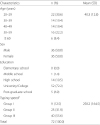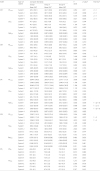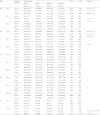5. Schlechtweg PM, Kammerer FJ, Seuss H, Uder M, Hammon M. Mobile image interpretation: diagnostic performance of CT exams displayed on a tablet computer in detecting abdominopelvic hemorrhage. J Digit Imaging. 2016; 29:183–188. DOI:
10.1007/s10278-015-9829-x. PMID:
26438423.

6. Fleischmann R, Duhm J, Hupperts H, Brandt SA. Tablet computers with mobile electronic medical records enhance clinical routine and promote bedside time: a controlled prospective crossover study. J Neurol. 2015; 262:532–540. DOI:
10.1007/s00415-014-7581-7. PMID:
25476692.

7. Crowson MG, Kahmke R, Ryan M, Scher R. Utility of daily mobile tablet use for residents on an otolaryngology head & neck surgery inpatient service. J Med Syst. 2016; 40:55. DOI:
10.1007/s10916-015-0419-8. PMID:
26645319.

8. Motulsky A, Wong J, Cordeau J-P, Pomalaza J, Barkun J, Tamblyn R. Using mobile devices for inpatient rounding and handoffs: an innovative application developed and rapidly adopted by clinicians in a pediatric hospital. J Am Med Inform Assoc. 2017; 24:e69–e78. PMID:
27554824.

9. Jeon M-J, Kim C-Y, Chung J-H, Lim W-T, Sakong J. Effects of familiarity with computer and type of keyboard on computerized neurobehavioral performance tests. Korean J Occup Environ Med. 2004; 16:178–190.

10. Sakong J, Chung J-H, Lee H-Y. Interrelation of neuropsychiatric symptom and neurobehavioral test among workers exposed to organic solvents. Korean J Occup Environ Med. 1997; 9:49–60.

11. Chung J-H, Kim C-Y, SaKong J, Jeon M-J, Park H-C. Development of Korean neurobehavioral test battery -assessment of the validity of traditional and computerized neurobehavioral tests. J Prev Med Pub Health. 1998; 31:692–707.
12. Sakong J, Jeon M-J, Sung N-J, Kim G-T. Impact of subjects' characteristics and test conditions on reliability of neurobehavioral tests. Korean J Occup Environ Med. 2003; 15:188–195.
13. Sakong J, Chung J-H, Jeon M-J, Shin M-S. Evaluation of reliability of traditional and computerized neurobehavioral tests. Korean J Occup Environ Med. 2000; 12:494–500.

14. Baek NJ, Park GI, Byun YS, Jeon MJ, Sakong J. Effects of computer familiarity and computer type on the performance of Korean computerized neurobehavioral test. Ann Occup Environ Med. 2016; 28:44. DOI:
10.1186/s40557-016-0129-9. PMID:
27617101.

15. Kim G-T, Kim C-Y, Sakong J. Effect of the type of computer on computerized neurobehavioral performance tests. Korean J Occup Environ Med. 2004; 16:276–286.

16. Kim Y-C, Jeon M-J, Hong Y-C, Lee C-G, Ha M-N, Kwon H-J, et al. Association between blood lead concentration and computerized neurobehavioral performance in Korean elementary school students. Korean J Occup Environ Med. 2011; 23:183–191.

17. Sakong J, Jeon M-J, Yun S-H, Hong Y-C, Lee C-G, Kim Y-K, et al. Association of blood mercury level and neurobehavioral performance in Korean elementary school students. Korean J Occup Environ Med. 2010; 22:324–330.

18. Jeon MJ. Neurobehavioral performance in fishery divers suffered from decompression sickness. Kosin Med J. 2008; 23:182–187.
19. Sakong J, Baek S-O, Jeon M-J. Formaldehyde, volatile organic compounds inside newly produced vehicle and neurobehavioral performance of vehicle drivers. J Korean Soc Indoor Environ. 2009; 6:111–122.
20. Kim D-S, Kim S-J, Park S-Y, Jeon M-J, Kim G-T, Kim C-Y, et al. The effects of indoor air quality on the neurobehavioral performance of elementary school children. Korean J Occup Environ Med. 2007; 19:65–72.

21. U.S. National Committee for the International Union of Psychological Science, Commission on Behavioral and Social Sciences and Education, Division of Behavioral and Social Sciences and Education, National Research Council. Behavioral measures of neurotoxicity. 1990. Washington, DC: National Academies Press.
22. Weiss B, Elsner J. Risk assessment for neurobehavioral toxicity. 1997. Darby: DIANE Publishing.
23. Kim JS, Kim SA, Lee CY, Park SW, Nam SH, Lee JY, et al. Effects of number and method of visual stimuli on simple reaction time. Korean J Occup Environ Med. 1996; 8:477–489.

24. Hudnell HK, Otto DA, House DE. The influence of vision on computerized neurobehavioral test scores: a proposal for improving test protocols. Neurotoxicol Teratol. 1996; 18:391–400. DOI:
10.1016/0892-0362(96)00040-2. PMID:
8866529.

25. Viau A, Najm M, Chapman CE, Levin MF. Effect of tactile feedback on movement speed and precision during work-related tasks using a computer mouse. Hum Factors. 2005; 47:816–826. DOI:
10.1518/001872005775571023. PMID:
16553068.

26. Burke JL, Prewett MS, Gray AA, Yang L, Stilson FRB, Coovert MD, et al. Comparing the effects of visual-auditory and visual-tactile feedback on user performance: a meta-analysis. Proc 8th Int Conf Multimodal Interfaces. 2006. Banff: ACM;p. 108–117.
27. Santos-Carreras L, Leuenberger K, Samur E, Gassert R, Bleuler H. Tactile feedback improves performance in a palpation task: results in a VR-based testbed. Presence Teleoperators Virtual Environ. 2012; 21:435–451. DOI:
10.1162/PRES_a_00126.

28. Rabin E, Chen J, Muratori L, DiFrancisco-Donoghue J, Werner WG. Haptic feedback from manual contact improves balance control in people with Parkinson's disease. Gait Posture. 2013; 38:373–379. DOI:
10.1016/j.gaitpost.2012.12.008. PMID:
23313411.

29. MaxMedica Inc. KCN Test User's Guide. 2012. Seoul: MaxMedica Inc..









 PDF
PDF Citation
Citation Print
Print


 XML Download
XML Download